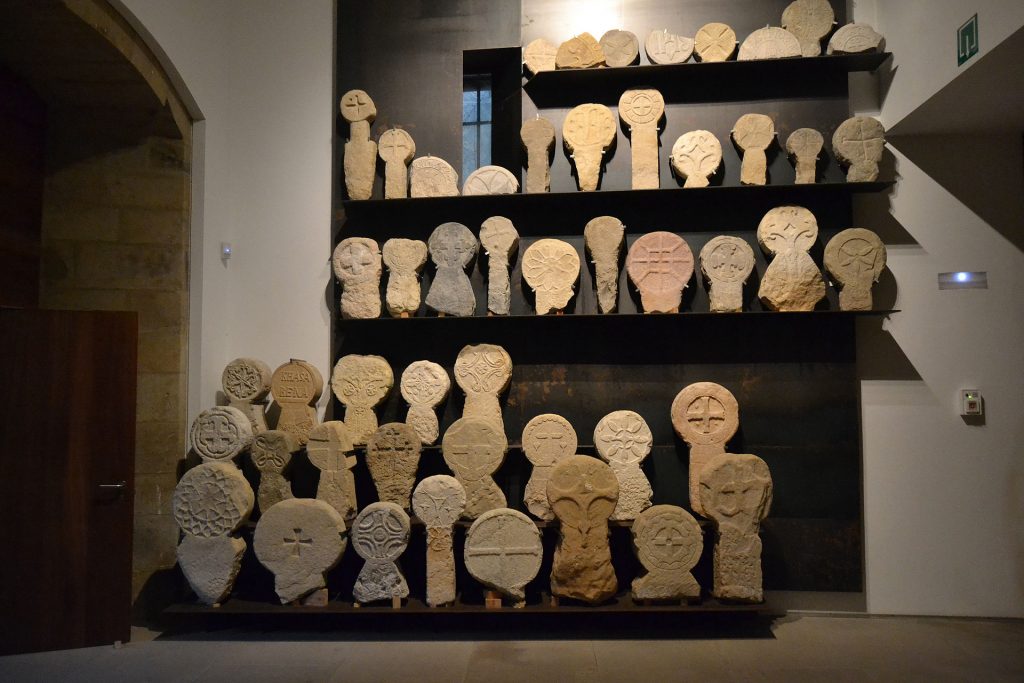During my first visit to the Basque Country, my cousin took me to Elorrio, not far from his hometown of Durango in Bizkaia. He took me and a friend to Argiñeta, which was simply amazing. They’ve collected a number of hilarriak, or funeral steles, there. These are large stone grave markers that are carved with a variety of symbols and designs that either speak to the dead person and their profession or more abstractly to the stars and the cosmos. Either way, they are a fascinating element of the Basque cultural heritage.

- While the discoidal steles, with their round tops sitting on trapezoidal bases, are not unique to the Basque Country, they are particularly common there. They’ve also been found in other parts of Western Europe and Northern Africa. A few have even been found in Britain. The circular part is decorated with geometric shapes or, more recently, Christian symbols, including crosses. Rosettes are very common, as are lauburus. The edge is often decorated to resemble the rays of the shining sun. And, at least in modern hilarriak, the base is engraved with the name of the deceased. The oldest discoidal hilarriak date to the Iron Age, but most of those found in Nafarroa, which has a particularly large number, date between the 11th and 18th centuries.
- One of the oldest discoidal steles was found in Berreaga, Bizkaia, in the lands surrounding the towns of Mungia, Zamudio and Gamiz-Fika. Decorated with solar imagery, it dates to the 1st or 2nd century BC. The stele was found in a necropolis, which has been designated a Cultural Asset by the Basque Government. While the site was discovered in the 16th century, excavations weren’t done until the late 20th and early 21st centuries.
- The Necropolis of Argiñeta, in Elorrio, Bizkaia, is a fascinating site. It contains multiple steles and sarcophagi that date back to between the 8th and 10th centuries. Built of sandstone from Mount Oiz, these hilarriak also feature astral designs, things like concentric circles, extended radial lines, and cross shapes. Some of the tombs have inscriptions that are the oldest evidence of Christianity in Bizkaia.
- There is also a museum dedicated to these hilariak. Located in the town of Larzabale in Nafarroa Beherea, Harriak Iguzkitan opened in 2007 and features nearly 100 pieces of art in an open air setting. It is the first interpretation center in the Basque Country dedicated to discoidal steles and Basque funerary art.
- Of course, not all hilarriak are discoidal. One early example, dating from the 1st century AD, is the Andrearriagako estela. This headstone is noteworthy because it is one of the few from that time in Gipuzkoa with an inscription. The inscription says “VAL BELTESONIS.” The second word seems to be connected to Aquitanian, or pre-Basque.
- Making an hilarria was a complicated process, requiring not only finding the right stones, but a wide selection of tools; something like twenty different tools were needed to carve the stone. Today, the art of making hilarriak is slowly fading. However, there are master crafters that continue on the tradition, such as Pello Iraizoz.
- Update! Marc Cormier pointed out that Basques left similar grave stones in Newfoundland!
Primary sources: Hilarri, Wikipedia; Estelas discoideas de Puente la Reina/Gares, Koldo Colomo Castro;
Discover more from Buber's Basque Page
Subscribe to get the latest posts sent to your email.



Greetings,
thank you for posting this info. I know where I will be going my next trip home! I remember that you posted in Sept. 2013 many rosettas that you had vectorized and clean up from the original book. I still have a copy as I wanted to embroidered some–someday. Time went by and life happened so that I could not get around to do anything with the rosettas–till now. I found a class exclusively for rosettes offered by the Embroiderers Guild of America starting in 2022.
When I go home (hopefully soon!!!) I will go to the museums mentioned in the post, with a copy of the drawing, and perhaps, with the help of the museum staff, be able to identify the location of some rosettes.
If everything goes well with the class, I will embroider one in memory of your Dad..I will even give it its Basque name and send it to you.
Till then you all have a great Thanksgiving dinner.
Monique
Thanks Monique! I hope you are able to head back home soon. And I would love to see the rosette once you’ve embroidered it! That is such a cool way to incorporate those designs! I hope you have a great Thanksgiving holiday as well. And, I’m touched that you would think of my dad that way!